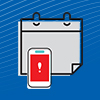Blog
4 strategies to streamline hospital codes
As healthcare professionals, we manage urgent and critical patient care situations every day. We train and prepare for emergencies so we can take immediate action to deliver the best care to our patients.
Effective and efficient clinical communications are at the foundation of a successful emergency response plan. Hospital code calls can range from overhead announcements to notifying dozens, or even hundreds of people. In some instances, like a large influx of patients following a disaster, the individuals who must respond may not be on-site at the hospital and must be alerted on whatever mobile device they are carrying at that time.
These four tips could help streamline your code response process and increase the quality of care delivered when time is not on your side.
1. Coordinate the right people quickly
Whether you are looking to improve patient satisfaction by improving response times in non-emergent situations or you need to improve your emergency responsiveness, coordinating the appropriate staff quickly is imperative.
There are several components that can make this part of the care puzzle easier:
- Keep on-call schedules up to date
- Deliver messages to appropriate individuals or groups—such as a code STEMI team for myocardial infarction (MI) patients—without needing to use time-consuming call trees
- Utilize technology to monitor response times and automatically escalate unanswered notifications to ensure that code team members respond quickly
Track call response times in critical hospital departments to maintain a baseline. Evaluate the communication workflows and your current technology for these three key components (on-call schedules, group messaging capabilities, and automatic escalations). Identify gaps for possible improvement.
See how Yale New Haven Health sent an emergency notification to over 20,000 people in eight minutes
2. Stay on top of the situation
Sending alerts to the right staff after initiating a code is just the first step in the code alerting process. If the message is not responded to promptly, patient care will likely suffer. It is critical to monitor emergency notifications as they unfold to ensure that all codes, alerts, and messages are received and acknowledged by the appropriate clinical personnel in a defined period of time. For whatever reason, when there is no response from any member of the code team, the alerting message should automatically escalate to another appropriate member of the team. For example, it is quite possible a respiratory therapist may be involved in an intubation and could not respond to the Code Blue alert within the agreed time window. The alerting system should automatically escalate and page another on-duty respiratory therapist to respond to the code. Real-time reporting and tracking allow for better oversight, as well as provide documentation which can be used for post code analysis and feed ongoing clinical process improvement.
3. Integrate communication channels
For patients with emergent conditions like a stroke or myocardial infarction (MI), time is muscle. Lost seconds can result in permanent, debilitating conditions or death. A clinical study describing approaches to decrease door-to-balloon time for MI patients, noted a nearly 14-minute time reduction by utilizing centralized communications to activate a code STEMI. Real-time data feedback gained another nine minutes. A central communication system which integrates with clinical monitoring can speed response and improve patient care by utilizing escalation capability to make sure that communications are responded to quickly.
Case study: Franciscan Health Michigan City cut code STEMI activation times by 43%
Review the communication infrastructure in your organization. Your communication system should work with the monitoring equipment your staff uses, allowing clinicians to set their alarm preferences for multiple devices, and support centralized calling, call escalation, tracking, and auditing.
4. Think beyond the medical code
Your communication infrastructure should be able to handle routine patient calls, provider-to-provider interactions, call escalations, and the timely reporting of test results. But it should also form the core of your disaster notification and response system to keep staff informed during staff shortages, major disasters, weather events, and outages like power or oxygen. It could be used to manage other types of notifications as well, such as clinical specimen storage refrigerator temperature, door access alarms, and even telemetry lead disconnects. Your system should easily handle the ordinary—and the extraordinary—notification and communication needs of your facility.
Some questions to consider:
- How do you inform staff about weather events or major events?
- Is your alerting process time-efficient to notify on-call staff they are needed?
- Do you have a comprehensive emergency notification and incident management system?
Hospital codes and your emergency notification system
When it comes to running codes, the goal is always to shave minutes off your code call process by increasing your efficiency. To continually improve, your emergency notification and incident management system should allow you to accomplish all of the following:
- Coordinate the appropriate code team members quickly, including on-call and remote staff
- Verify that code alert messages have been received and that code team members are on their way with real-time monitoring and automatic escalations
- Use an audit trail of all code alert activity for continuous quality improvement
- Provide code team critical clinical information – STAT
- Use a device agnostic system which would allow you to contact code team members on any communication device they carry
- Think beyond just clinical codes and use your alerting system for fire alarms, weather events, and other non-medical emergencies that require rapid response
Hospitals run more efficiently when communications flow smoothly. From code calls and critical test result alerts, to provider-to-provider communications, efficient and timely notifications can speed care and improve clinical outcomes. Your code call process should be viewed as an integral part of the overall technology infrastructure of your hospital and health system. It should integrate with your other communication pathways and solutions. Eliminating call trees, tracking responses in real time, and maintaining an audit trail of event communications, are all proven methods to streamline hospital code calls and improve communications support for your staff and your patients.
Want to learn more about improving communications?
Download our free eBook: How to improve clinician experience through better communications






